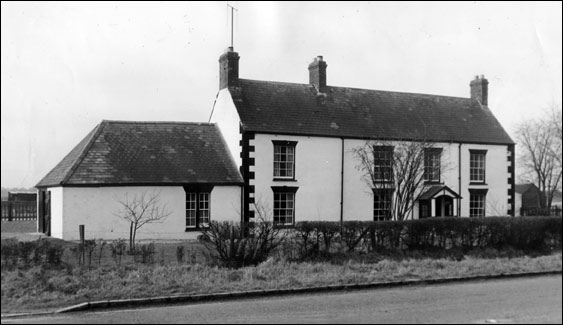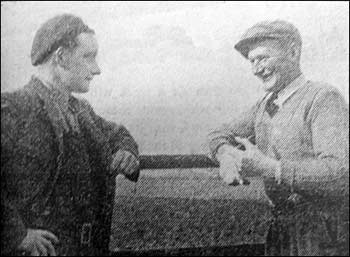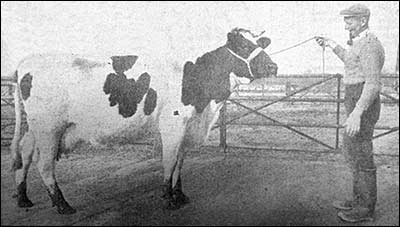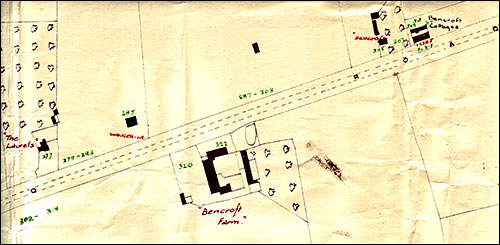|
|||||||||||||||||||||||
| The Rushden Echo and Argus, 5th March 1954, transcribed by Gill Hollis |
|||||||||||||||||||||||
|
Bencroft Grange Farm
|
|||||||||||||||||||||||
|
|||||||||||||||||||||||
|
Two-Man Farm – And Not an Acre is Idle
|
|||||||||||||||||||||||
|
Many travellers on the Rushden-Bedford road will have noticed a black and white farmhouse – an unusual style for this part of the country. The farm, Bencroft Grange, is almost on the county boundary between Northamptonshire and Bedfordshire and is the home of the Benecroft herd of attested British Friesians, the property of Mr. Harry Holt. Until four years ago Mr. Holt farmed with his father and brother at Higham Park, but since then he has branched out on his own at Bencroft Grange.
One promising heifer, “Benecroft Benefit,” gave 1,800 gallons at four per cent butter fat with her first calf, and has given 600 gallons in 85 days with her second calf. Her twin sister gave 1,600 gallons at four per cent with her first calf. The bull being used is a young one. Lavenham-Terling. The present policy is to get as many strains of it as possible in the herd. Several bull calves are reared and sold annually. Two years ago at the Friesian sale at Reading a young bull twelve months old made 500 guineas. The 140-acre farm consists of about 80 acres of leys, with the rest devoted to growing cash crops and fodder crops. The only labour employed throughout the year is Mr. Holt himself and Mr. M. Goodes of Sharnbrook. At harvest time a neighbour’s combine is used. Mr. Holt reciprocates by using his pick-up bailer on his neighbour’s farm. There is no grain drier, but there is storage for about 320 quarters of grain in four bins, which have been erected under the same roof as the cowshed. As it is required, grain can be mixed easily and put through the hammer mill; handling is reduced to a minimum in feeding the cows because of the close proximity of the cowshed. About thirty acres of leys are taken for hay every year, and any surplus grass is put into the stack of silage. The cows are fed on hay, kale and silage, the production ration being made up of home-grown food and high protein cake. Water Laid on the Fields Heavy stocking on the leys is obtained by the judicious use of fertilisers and the electric fence. Some six cwts of slag and three cwts of complete fertiliser per acre are used annually. Only small limited quantities of straight nitrogen are used, as Mr. Holt feels the clover content of his swards is damaged by large applications. Water is laid on to every field on the farm and by means of the electric fence the fields are divided into six-acre paddocks. The cows spend an hour in the morning and evening on these paddocks, and are then rested on an adjoining field. Each paddock is grazed for about a week. Any surplus is cut with the green crop loader and made into silage; this winter about 60 tons of good grass silage was made by this method. All the farmyard manure made is put on the leys that are to be cut for hay. A ley is usually taken for hay in its last year before being ploughed out. The rotation adopted consists of four years in grass and four years in arable. All straw crops are under-sown with a mixture of trefoil and Italian ryegrass for providing extra keep for the dairy cattle after harvest. ‘Early Bite’ For The Cows
An “early bite” is always prepared for the cows by dressing part of the leys with nitrogen in mid-February. As the land is extremely cold and very heavy, it is not possible to obtain an early bite by the end of March, but early grazing usually begins about the second week in April. All the cereals are combine drilled with a minimum quantity of one and a half cwt of complete fertiliser, varieties favoured being Hybred 46 for the wheat and Plumage Archer for the barleys, it usually being possible to grow a good malting sample. Oats receive about three cwts of complete fertiliser, the variety preferred being S172. All the land is deep ploughed in addition to being sub-soiled to about 20 inches. 200 Head of Poultry About 200 head of poultry are kept for commercial egg production, these being on deep litter in the winter and on free range in the summer. The county’s first apprentice to agriculture under the N.F.U. apprentices’ scheme started work with Mr. Holt this week. Local N.F.U. secretaries can supply details of the scheme to any young men wishing to make agriculture their career. There is no doubt that Bencroft Grange is a holding producing a tremendous output per acre in terms of milk, due to Mr. Holt’s fine management of the dairy herd. The leys last summer looked extremely well, as a result of Mr. Holt’s manorial and grazing policy. Another ten acres is about to be brought into production this coming summer by the reclaiming this winter of ten acres of extremely thick, bushy ground. This, when reclaimed, will be fallowed and direct re-seeded, which will mean that there will not be an idle acre on the farm. |
|||||||||||||||||||||||
|
|||||||||||||||||||||||



